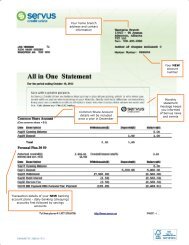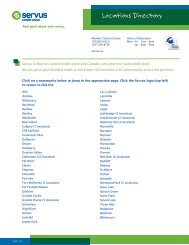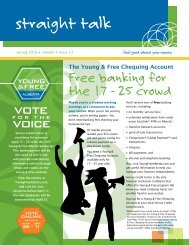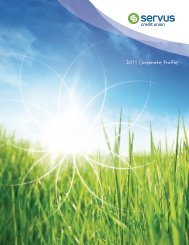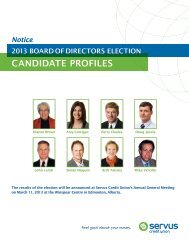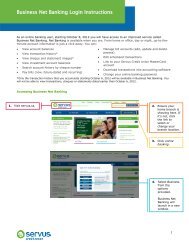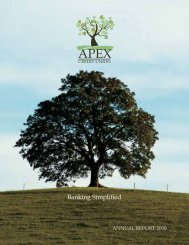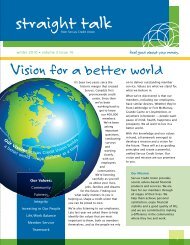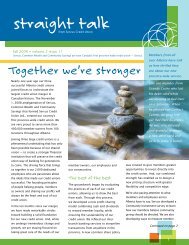Understanding the Basics - Servus Credit Union
Understanding the Basics - Servus Credit Union
Understanding the Basics - Servus Credit Union
- No tags were found...
You also want an ePaper? Increase the reach of your titles
YUMPU automatically turns print PDFs into web optimized ePapers that Google loves.
This <strong>Understanding</strong> All The <strong>Basics</strong> booklet (this“publication”) is provided to you courtesy of a credit union.It is written in everyday language – answering to <strong>the</strong> needexpressed by many credit union members for clear andunderstandable information on RRSPs and retirementincome options available to <strong>the</strong>m.This issue of <strong>Understanding</strong> All The <strong>Basics</strong> is based on <strong>the</strong>legislation in effect or proposed as of July, 2014. You shouldnot act (or refrain from acting) based upon informationin this publication without obtaining professional adviceregarding your particular facts and circumstances.This publication is provided for informational purposes only.The information in this publication is summary in nature anddoes not constitute legal or financial advice. <strong>Credit</strong> <strong>Union</strong>Central of Canada hereby disclaims all warranties as to <strong>the</strong>accuracy of any of <strong>the</strong> information in this publication anddisclaims all liability for any actions taken in reliance onthis information.Any copying, redistribution or republication of thispublication, or its content, is strictly prohibited.For fur<strong>the</strong>r information, you may contact <strong>the</strong> CanadaRevenue Agency (CRA) or refer to its T4040 RRSPsand O<strong>the</strong>r Registered Plans for Retirement guide.
What’s New?Ontario Pension LegislationEffective January 1, 2014, application for release of lockedinfunds due to financial hardship must be submitted to<strong>the</strong> financial institution instead of <strong>the</strong> Financial ServicesCommission of Ontario (FSCO). The FSCO will not approveor accept financial hardship applications.
Table of ContentsRRSPWhat is an RRSP? 1What Does an RRSP Mean to You? 1What Happens at Retirement? 2Who is Eligible to Contribute? 2Definitions of Spouse/Common-law Partner 2What is Earned Income? 3RRSP Deduction Limits 3Special Transfers to Your RRSP 5Contributing to RRSPs in Your Spouse’s Name 6Removal of Contributor Detail FollowingBreakdown of Marriage/Common-law Partnership 7Carry Forward Unused Deduction Room 8Carry Forward of Undeducted Contributions 8Contribution Deadline 8Over-contributions 9Can You Borrow for an RRSP? 9Official Receipt 10Who Sells RRSPs/RRIFs? 10How Safe are RRSP/RRIF Investments? 10<strong>Credit</strong>or Protection 10What Types of RRSPs are Available? 12Self-Directed Plan 13Group RRSPs 13Income Tax Considerations 14What Does an RRSP Cost? 14What Should You Look for in an RRSP? 15Benefits and Advantages 15Can You Transfer Your RRSP? 16RRSP Transfers FollowingRelationship Breakdown 16Can You Withdraw Funds? 16
Withdrawals from Spousal RRSPs 16The Home Buyers’ Plan 17The Life Long Learning Plans 20Locked-In RRSP/LIRA/RLSP 21Is There Withholding Tax? 22Can You Leave Funds in an RRSP Indefinitely? 22Designation of Beneficiary 22What Happens if You Die? 25Contributions After Death 25Retirement Income OptionsHow Does an RRSP Provide Retirement Income? 26What Options are Available? 26When Can You Start to ReceiveRetirement Income? 26Is Retirement Income Taxable? 27Withholding Tax 27Pension Income <strong>Credit</strong> 27When Should You Buy? 28Registered Retirement Income Fund (RRIF) 28Life Income Fund (LIF) 31Restricted Life Income Fund (RLIF) 32Variable Benefit (VB) 32Locked-In Retirement Income Fund (LRIF) 32Saskatchewan RRIF (SK RRIF) 33Manitoba RRIF (MB RRIF) 33Benefits and Advantages 33Term Certain Annuity to Age 90 (TCA 90) 34Life Annuity 34Are There Any Risks Involved? 35Can You Commute YourRetirement Income Options? 35What Happens in Case of Death? 36Who Sells Retirement Income Options? 37How Do You Choose an Option? 37Calculation of RRSP Deduction Limit 38
RRSPWhat is an RRSP?A Registered Retirement Savings Plan is a governmentapproved plan through which you save money for yourretirement years. Your contributions, within limits, aretax deductible, and <strong>the</strong> income earned is tax sheltered.You can have any number of plans.What Does an RRSP Mean to You?You are investing money when you can most afford itduring your peak earning years – to build up a comfortableretirement fund.The following graph shows <strong>the</strong> amount you couldaccumulate by annual RRSP contributions of $1,000 at<strong>the</strong> beginning of each year, assuming constant interestrates of 1.5%, 2.5% and 4% p. a.Value (thousands of dollars)605040302010010years15years20years25years30yearsAssumed compound interest rate:1.5% p.a. 2.5% p.a. 4% p.a.Not only do you invest some money that would o<strong>the</strong>rwisebe paid in taxes, but <strong>the</strong> earnings of your plan are not taxeduntil you withdraw <strong>the</strong>m. Since 100% of <strong>the</strong>se earnings canbe reinvested and compounded, <strong>the</strong> growth of your RRSPincreases rapidly over <strong>the</strong> years, as <strong>the</strong> above graph shows.Your retirement savings will also increase significantlyif you make each RRSP contribution as soon as allowed,for example, early in <strong>the</strong> year.UNDERSTANDING ALL THE BASICS 1
What Happens at Retirement?The first stage of an RRSP is to accumulate retirementsavings. The next stage is to provide retirement income.Your accumulated savings may be invested in a variety ofoptions to provide a retirement income which can continuefor life or to age 90. Only <strong>the</strong> retirement income paymentsare taxed each year as you receive <strong>the</strong>m, thus spreading<strong>the</strong> taxation of your accumulated savings over yourretirement years.Who is Eligible to Contribute?Anyone with “earned income” subject to Canadiantaxation, including non-residents, may contribute to anRRSP. Even if you are not taxable, you should file a taxreturn to report your earned income and create RRSPdeduction room.You can make part or all of any contribution toa plan in your spouse’s or common-law partner’sname. You, as <strong>the</strong> contributor, are still entitled to <strong>the</strong>tax deduction. Contributions can be made until <strong>the</strong> endof <strong>the</strong> year in which <strong>the</strong> planholder’s 71st birthday occurs.An over-contribution (see page 9) can be carriedforward beyond this year and deducted in subsequentyears providing you have earned income on which tobase <strong>the</strong> deduction.Definitions of Spouse/Common-law PartnerIncome tax legislation defines <strong>the</strong> term “spouse” to bea person who is party to a legal marriage.The term ‘common-law partner’ is defined as two persons,regardless of sex, who cohabit in a conjugal relationshipand who have cohabited throughout <strong>the</strong> 12 month periodthat ends at that time. This period can be less than 12months if both partners are <strong>the</strong> natural or adoptive parentsof <strong>the</strong> same child, or if one common-law partner has a childwho is wholly dependent on <strong>the</strong> o<strong>the</strong>r for support and overwhom <strong>the</strong> o<strong>the</strong>r has custody.The term “common-law partner” does not apply if at <strong>the</strong>particular time <strong>the</strong> individuals were separated for 90 daysor more due to a breakdown of <strong>the</strong> conjugal relationship.2UNDERSTANDING ALL THE BASICS
What is Earned Income?Your RRSP deduction is based on your prior year’searned income. The following qualify as earned income:• salary, wages, bonuses and taxable fringe benefits(minus union or professional dues and employmentexpenses claimed as deductions)• taxable wage loss replacement or long-term disabilityincome resulting from employment• Canada Pension Plan disability benefits• amounts received under <strong>the</strong> Wage Earner ProtectionProgram Act• net income from self-employment(minus current year business losses)• net rental income from real estate(minus current year rental losses)• taxable alimony or maintenance payments received• royalties of an author or inventor• net research grantsNOTES:1. Earned income must be reduced by deductible alimony or maintenancepayments.2. Interest, dividend, capital gains income, and E.I. benefits, do not qualifyas earned income.3. Income which is not taxed, such as Workers’ Compensation and welfarebenefits, cannot be used as earned income.A worksheet is provided on page 38 of this booklet toassist you in calculating your earned income. CRA alsoprovides a form for <strong>the</strong> calculation of earned incomein its Guide T4040 RRSPs and O<strong>the</strong>r Registered Plansfor Retirement.RRSP Deduction LimitsYour Notice of Assessment from CRA, received afterfiling your tax return, will state your RRSP deduction limitfor <strong>the</strong> following year. At certain times of <strong>the</strong> year, youcan also phone <strong>the</strong> CRA Tax Information Phone Service1.800.267.6999 (TIPS) to confirm your deduction limit.The calculation of <strong>the</strong> amount will depend on whe<strong>the</strong>r youare a member of a pension plan, and if you are, <strong>the</strong> type ofpension plan.UNDERSTANDING ALL THE BASICS 3
Your RRSP deduction limit (preceding paragraph) doesnot include special transfers to your RRSP (see page 5).NOTE: The amount of RRSP contributions you can deduct from your income(“RRSP deduction limit”) may be less than <strong>the</strong> amount you can contribute (seeOver-contributions, page 9). Employer contributions made to an RRSP on yourbehalf form part of your RRSP contribution.The worksheet on page 38 of this booklet may enable you to calculate yourRRSP deduction limit.CAUTION: Before making any RRSP deduction, make sure you will still be fullyutilizing your available tax credits for <strong>the</strong> year.Maximum DeductionThe maximum RRSP contribution you may deduct for <strong>the</strong>current year is:• 18% of your earned income for <strong>the</strong> prior year, up to<strong>the</strong> maximum amount for <strong>the</strong> current year; MINUS Your“Pension Adjustment” (PA)* for <strong>the</strong> prior year and “PastService Pension Adjustment” (PSPA)** PLUS Your“Pension Adjustment Reversal”(PAR)***The present amounts are:Earned Income (in prior year)for maximum2013 $23,820 $132,3332014 $24,270 $134,8332015 $24,930 $138,500After 2015, this amount will be indexed by <strong>the</strong>average increase in industrial wages as publishedby Statistics Canada.* Your PA for <strong>the</strong> prior year should be on your T4 slips for that year.It reflects <strong>the</strong> value of future benefits arising from membership in aregistered pension plan (RPP) or deferred profit sharing plan (DPSP).If you were not a member of a RPP or DPSP in <strong>the</strong> prior year, your PAis zero. If you were a member of a “money purchase” RPP or a DPSP,<strong>the</strong> PA is <strong>the</strong> total contributions to <strong>the</strong> RPP or DPSP in respect to <strong>the</strong> prioryear by you, or on your behalf by your employer, union, etc. If you were amember of a “defined benefit” RPP, <strong>the</strong> PA is determined by a complexformula. You may wish to ask your employer how it is calculated.** “Uncertified PSPA”, or an upgrade to a pension plan, affects RRSPdeduction limits for <strong>the</strong> following year. “Certified PSPA”, or a pensionbuyback for an individual, affects <strong>the</strong> year of buyback or <strong>the</strong> year <strong>the</strong>information is sent to CRA.*** A Pension Adjustment Reversal (PAR) may arise if you are a member ofa defined benefit RPP and <strong>the</strong> pension is not vested when you terminateyour employment.4UNDERSTANDING ALL THE BASICS
The greater <strong>the</strong> future benefits provided by your pensionplan, <strong>the</strong> less you will be able to deduct as RRSPcontributions. This addresses <strong>the</strong> main objective of <strong>the</strong>Retirement Savings legislation – to create equality in <strong>the</strong>tax-sheltered retirement benefits available to all taxpayers,regardless of <strong>the</strong>ir type of pension plan, or whe<strong>the</strong>r <strong>the</strong>yare self-employed, or employed but have no pension plan.Special Transfers to Your RRSPIn addition to your RRSP deduction limit, <strong>the</strong>re are a numberof special deposits you can make to your RRSPs.Lump Sum TransfersYou can transfer lump sums DIRECTLY from a RegisteredPension Plan or a Deferred Profit Sharing Plan (DPSP)to your RRSP.You can transfer amounts DIRECTLY from ano<strong>the</strong>r ofyour RRSPs (see page 15) or from your RRIF (see page 36)to your RRSP.RRIF Payments in Excess of MinimumUntil <strong>the</strong> end of <strong>the</strong> calendar year in which you turn 71,you can transfer DIRECTLY to an RRSP in your own nameup to 100% of any payment from your RRIF in excessof <strong>the</strong> mandatory minimum payment amount for <strong>the</strong> year.CRA form T2030 can be used for this purpose. The RRIFcarrier must provide a T4RIF to report <strong>the</strong> amounttransferred from your RRIF and <strong>the</strong> RRSP issuer mustprovide an Official Receipt for <strong>the</strong> amount transferredto your RRSP.Retiring AllowancesA retiring allowance is a lump sum or sums paid to you byyour employer, at or after your termination, in recognitionof your loss of employment. Accumulated sick leave creditspaid qualify under this definition, but holiday pay, deathbenefits and pension benefits do not. The portion of aretiring allowance eligible for sheltering in your own RRSPcan ei<strong>the</strong>r be transferred directly (no income tax deducted),or up to 100% can be contributed in <strong>the</strong> year of receipt orwithin 60 days <strong>the</strong>reafter. No portion of a retiring allowancecan go to an RRSP in your spouse’s name.UNDERSTANDING ALL THE BASICS 5
The maximum retiring allowance which can be sheltered is:• $2,000 for each full or partial calendar year of servicewith your current employer prior to 1996, plus• an additional $1,500 for each full or partial calendar yearof service prior to 1989 with your current employer,in which you were not a member of a pension plan orDPSP, or years for which your employer’s contributionsto such plans have not vested in you.The transfer of a retiring allowance to an RRSP doesnot affect your RRSP deduction limit for that year.RESP Accumulated IncomeProvided <strong>the</strong> RESP subscriber has sufficient RRSPcontribution room and is a Canadian resident, she/he cantransfer up to $50,000 of accumulated income from anRESP to an RRSP in <strong>the</strong> name of <strong>the</strong> subscriber or to aspousal RRSP in <strong>the</strong> name of <strong>the</strong> subscriber’s spouse.Any of <strong>the</strong> following conditions must be met:• <strong>the</strong> RESP must have been in existence for at least 10*years and all beneficiaries of <strong>the</strong> Plan are deceased, orall living individuals who are or were beneficiaries under<strong>the</strong> RESP have attained <strong>the</strong> age of 21 years and are notpursuing post-secondary education, or• <strong>the</strong> payment must be made in <strong>the</strong> 35th year following<strong>the</strong> year <strong>the</strong> Plan was entered into, or• each individual who was a beneficiary under <strong>the</strong> Planmust be deceased when <strong>the</strong> payment is made.Only amounts transferred within <strong>the</strong> subscribers RRSPdeduction limit and deducted in that year will avoid taxation.There is a special 20% surtax on excess accumulatedincome withdrawn by <strong>the</strong> subscriber.* The “10 year” and “age 21” rules may be waived in specialcircumstances.Contributing to RRSPs in Your Spouse’s NameNOTE: Throughout this booklet:– <strong>the</strong> term spouse can also be read as common-law partner(see definition on page 2)– <strong>the</strong> term spouse in <strong>the</strong> locked-in pension information also includeso<strong>the</strong>r individuals who have been given similar rights under applicablepension legislation– reference to spousal plan includes common-law partner plan6UNDERSTANDING ALL THE BASICS
Part or all of your RRSP deduction limit (see page 3)can be contributed to RRSPs for your spouse.Any amounts you contribute to RRSPs for your spouseare subject to an attribution period. (See Withdrawalsfrom spousal RRSPs, page 16.)If one spouse will be in a higher tax bracket in retirement,as much of <strong>the</strong> RRSP funds as possible should beaccumulated in <strong>the</strong> name of <strong>the</strong> spouse who will be in <strong>the</strong>lower bracket. The income eventually created from <strong>the</strong>funds will <strong>the</strong>n be taxed at that spouse’s lower tax rate.To set up a spousal RRSP, your spouse applies for a planin his or her name, even though your spouse may not haveany earned income. Although you make <strong>the</strong> contributionsto <strong>the</strong> plan, <strong>the</strong> assets of <strong>the</strong> plan belong to your spouse.Even if you are over 71, you can contribute to an RRSP foryour spouse until <strong>the</strong> end of <strong>the</strong> calendar year in which yourspouse turns 71.If your spouse also wishes to contribute to an RRSP basedon his or her own income, a plan separate from <strong>the</strong> spousalplan is strongly recommended.One final note – having RRSP funds in both spouses’names will ensure that both of you can qualify for <strong>the</strong>pension income credit by age 65 (see page 27).Removal of Contributor Detail FollowingBreakdown of Marriage/Common-lawPartnershipCRA will permit <strong>the</strong> removal of <strong>the</strong> contributor detailfollowing relationship breakdown. You must request<strong>the</strong> removal of <strong>the</strong> contributor’s name on your RRSPcontract. In addition, you are required to provide writtenconfirmation that:• you are no longer living with <strong>the</strong> contributor dueto relationship breakdown;• <strong>the</strong>re were no spousal contributions made to any spousalRRSP in <strong>the</strong> calendar year you are making <strong>the</strong> request,nor in <strong>the</strong> two immediately preceding calendar years; and• you have not withdrawn funds from <strong>the</strong> particular RRSPin <strong>the</strong> current calendar year.UNDERSTANDING ALL THE BASICS 7
Carry Forward Unused Deduction RoomIf you don’t claim your maximum RRSP deduction, you cancarry forward <strong>the</strong> unused deduction room indefinitely. Thisapplies whe<strong>the</strong>r or not you actually make a contribution.Your Notice of Assessment from CRA records anycumulative deduction room in determining your maximumRRSP deduction for <strong>the</strong> current year.If you don’t have <strong>the</strong> cash to contribute now, you can makelarger catch-up contributions in future years when youhave <strong>the</strong> cash available. But remember, you maximize yourretirement savings by making each RRSP contribution asearly as possible.Carry Forward of Undeducted ContributionsIf you have <strong>the</strong> cash to contribute now, but expect yourincome to be taxed at a higher rate in <strong>the</strong> future, you cancontribute now and claim <strong>the</strong> deduction in a future year oryears. This strategy is not penalized as an over-contributionas long as your contributions are within your deductionroom. And it has <strong>the</strong> advantage of tax-sheltering <strong>the</strong>earnings on your contribution.The official tax receipt should be filed with your tax returnin <strong>the</strong> year of contribution, even if not deducted, and<strong>the</strong> amount reported on Schedule 7 of your tax return.Contribution DeadlineYou may contribute at any time during <strong>the</strong> year.Contributions made during <strong>the</strong> first 60 days of any yearmay be deducted for <strong>the</strong> current or <strong>the</strong> immediatelypreceding taxation year.CRA has confirmed that if <strong>the</strong> last day of <strong>the</strong> 60-day periodfalls on a Saturday or Sunday, <strong>the</strong> deadline will be extendedto <strong>the</strong> following Monday.If you are contributing by mail, your application and/ordeposit must be received by <strong>the</strong> plan issuer on or before<strong>the</strong> contribution deadline.8UNDERSTANDING ALL THE BASICS
Over-contributionsOver-contributions are contributions that exceed yourdeduction room. An over-contribution of up to $2,000 canbe made by an individual who was 18 years of age or overin <strong>the</strong> prior year, and can be carried forward indefinitely.If you make contributions which increase your overcontributionabove $2,000, you will pay a 1% penalty taxper month on <strong>the</strong> amount in excess of $2,000.Non-voluntary (normally employer) contributions to groupRRSPs based on current earnings are not taken into accountuntil after <strong>the</strong> end of <strong>the</strong> year in which <strong>the</strong>y are made.At that time, your additional deduction room for <strong>the</strong> currentyear will reduce <strong>the</strong> excess.Any excess contribution you cannot deduct may berefunded without additional taxation. You must receive arefund subject to <strong>the</strong> above penalty in <strong>the</strong> year you overcontributed,in <strong>the</strong> year <strong>the</strong> Notice of Assessment for thatyear is issued, or in <strong>the</strong> following year. However, if CRA canprove that at <strong>the</strong> time you made <strong>the</strong> contribution you had noreasonable prospect of being able to deduct it for that yearor for <strong>the</strong> prior year, and that you made part or all of <strong>the</strong>contribution with <strong>the</strong> intent of withdrawing it tax-free, <strong>the</strong>ycan deem <strong>the</strong> refund of <strong>the</strong> over-contribution to be taxableto you. Therefore you should not intentionally make anover-contribution unless you are sure you will be ableto use it as your RRSP deduction in one or more futureyears, based on earned income.You can carry forward an over-contribution beyond <strong>the</strong> yearin which you turn 71. You can deduct part or all of it in anysubsequent year within your deduction limit.Can You Borrow for an RRSP?Yes, but you cannot deduct interest on money you borrowto contribute to an RRSP. You should not use an RRSP assecurity for a loan. If you do, you could be taxed on <strong>the</strong>value of <strong>the</strong> plan.UNDERSTANDING ALL THE BASICS 9
Official ReceiptAfter your RRSP contribution has been processed by<strong>the</strong> RRSP issuer, you will receive an official receipt. Thismust be filed with your tax return for that year even ifyou choose not to deduct it until a later year. Financialinstitutions are required to report all RRSP contributionsto CRA. If you do not report <strong>the</strong> contribution on your taxreturn for that year, <strong>the</strong> CRA will contact you.Who Sells RRSPs/RRIFs?<strong>Credit</strong> unions, trust companies, life insurance, mutual fundcompanies, banks and investment dealers all sell RRSPs/RRIFs (including locked-in plans such as LIRA, LIF, etc.).While all RRSPs/RRIFs provide <strong>the</strong> same tax deduction,not all plans are <strong>the</strong> same. Each issuer/carrier offers oneor more ways to invest your money, and <strong>the</strong> growth rates,terms, conditions and fees vary.How Safe are RRSP/RRIF Investments?Before you invest in any RRSP/RRIF, ask about depositinsurance protection. There is no insurance on mutualfunds, nor on most investments commonly held in selfdirectedRRSPs/RRIFs.<strong>Credit</strong>or ProtectionIn addition to RRSPs issued by insurance companies,<strong>the</strong>re are a number of o<strong>the</strong>r options available to providecreditor protection of RRSPs and RRIFs held with o<strong>the</strong>rfinancial institutions:• Federal legislationThe Bankruptcy and Insolvency Act protects bankruptindividuals’ RRSPs and RRIFs from creditors. To preventabuse, RRSP contributions made in <strong>the</strong> 12-month periodprior to bankruptcy will not be protected.It is important to note that this legislation will not preventcreditors in most provinces from claiming against RRSPand RRIF funds in cases where <strong>the</strong> annuitant has notfiled for bankruptcy.10UNDERSTANDING ALL THE BASICS
• Provincial legislation– The Alberta Civil Enforcement Act provides protectionof RRSP/RRIF funds, held by annuitants residingin Alberta, from any enforcement process with <strong>the</strong>exception of an enforcement under <strong>the</strong> MaintenanceEnforcement Act. An enforcement in process prior toNovember 1, 2010 is not protected.– The British Columbia Court Order Enforcement Actprovides protection of RRSP/RRIF funds, held byannuitants residing in British Columbia, from creditorswith <strong>the</strong> exception of an enforcement under <strong>the</strong> FamilyMaintenance Enforcement Act. An enforcementprocess commenced prior to November 1, 2008, is notprotected.– The Manitoba Registered Retirement Savings ProtectionAct provides protection of RRSP/RRIF funds, held byannuitants residing in Manitoba, from creditors with <strong>the</strong>exception of enforcement under The Family PropertyAct or The Family Maintenance Act. An enforcement inprocess prior to November 1, 2007, is not protected.– The Newfoundland and Labrador JudgmentEnforcement Act provides protection of RRSP/RRIFfunds held by annuitants residing in Newfoundlandand Labrador from creditors with <strong>the</strong> exception ofenforcement under <strong>the</strong> Support Orders EnforcementAct, 2006. An enforcement in process prior to April 5,2007, is not protected.– The Prince Edward Island Designation of BeneficiariesUnder Benefit Plans Act provides protection of RRSPand RRIF funds from execution or seizure, held byannuitants residing in Prince Edward Island, wherea designation in favour of a spouse, child, grandchildor parent of an annuitant is in effect.– The Saskatchewan Registered Plan (Retirement Income)Exemption Act provides protection of RRSP/RRIF fundsfrom creditors with <strong>the</strong> exception of enforcement under<strong>the</strong> Enforcement of Maintenance Orders Act, 1997. If<strong>the</strong> Court determines <strong>the</strong> jurisdiction of <strong>the</strong> RRSP/RRIFannuitant to be Saskatchewan, <strong>the</strong> RRSP/RRIF will beprotected from creditors.UNDERSTANDING ALL THE BASICS 11
• Pension legislation – In most cases, <strong>the</strong> fundscannot be attached by a third party demand. There areexceptions, however, and certain types of third partydemands may be honoured. (For example, a garnishingorder issued under matrimonial property legislation maybe effective against locked-in funds.)What Types of RRSPs are Available?There are three basic types of individual plans available:Deposit Type Plans, Mutual Funds, and Self-Directed Plans.The following is a short description of each plan – butremember that plan features will vary among issuers.Deposit-Type PlansDeposit-type RRSPs are <strong>the</strong> most common plans. Theyoffer familiar savings options including saving accounts,term deposits or guaranteed investment certificates.The rate of interest may be variable, fixed or index-linked.Key choices include <strong>the</strong> term of <strong>the</strong> deposit (ranging fromdaily to multi-year); and frequency of interest calculationsand payments to <strong>the</strong> RRSP (daily, monthly, annually, orend of term). Key considerations include <strong>the</strong> issuer’s policyregarding early withdrawals (your investment may be nonredeemablefor <strong>the</strong> term); and deposit insurance coverage.Mutual Funds*There are many types of funds available. Common typesare money market funds, income funds and equity funds.The first is invested in short-term securities such astreasury bills, and government and corporate notes. Incomefunds have <strong>the</strong> same investments from time to time, butpredominantly invest in longer term bonds and mortgages.An RRSP-eligible equity fund invests primarily in stocks.There are also balanced funds which hold all three types ofinvestments.The funds are divided into units. Unit values are updatedfrequently based on <strong>the</strong> market value of <strong>the</strong> investments.When mutual funds are held in an RRSP, income orcapital gains distributions are commonly used to purchaseadditional units.12UNDERSTANDING ALL THE BASICS
Since mutual fund investments do and will fluctuate invalue, <strong>the</strong>y don’t provide a guaranteed rate of return. Mutualfunds are not covered by deposit insurance. Sales fees,called front-end or back-end loads, can be charged on <strong>the</strong>acquisition or redemption of units. In addition, all mutualfunds pay management fees.*Available through dealers conveniently located in many credit unionsSelf-Directed PlanWith this kind of plan, you can make all your owninvestment decisions within a wide range of qualifiedinvestments. A trustee does all <strong>the</strong> administration workfor you. A self-directed plan may be uneconomical forthose with limited RRSP funds, because of <strong>the</strong> normaladministration and transaction fees.Self-directed plans are suitable for those with considerableinvestment experience and ample time to manage <strong>the</strong>funds, or for those who want all <strong>the</strong>ir RRSP investmentswithin one plan.Plans involving mortgages usually incur substantially higherfees. It is permissible to hold within your self-directedRRSP a mortgage on any property you own (non-arm’slength mortgage) that is eligible for mortgage insurance.This will result in additional mortgage insurance, legal andpossible appraisal fees. Generally, you should only do thiswith more than $25,000 of RRSP funds, and should planfor <strong>the</strong> mortgage to exist for more than three years.More than one self-directed RRSP can invest in <strong>the</strong>same mortgage. Only in certain pension jurisdictionscan Locked-in RRSPs, LIRAs, and RLSPs (see page 21)be invested in a non-arm’s length mortgage.Group (Employer-Sponsored) PlansGroup RRSPs have become popular in recent years asmore and more employers make <strong>the</strong>m available to <strong>the</strong>iremployees. They can have all <strong>the</strong> same investmentoptions as <strong>the</strong> o<strong>the</strong>r types of plans. An individual accountis maintained within <strong>the</strong> group RRSP for each participatingemployee. A group RRSP can also provide for an employeeto contribute to an account in <strong>the</strong>ir spouse’s name.Contributions to a group RRSP by an employer form partof <strong>the</strong> employee’s deduction limit.UNDERSTANDING ALL THE BASICS 13
They are also taxable income to <strong>the</strong> employee, offsetby receiving an RRSP contribution receipt. You may notbe able to withdraw <strong>the</strong> employer’s contributions and/oryour own contributions, and <strong>the</strong> income <strong>the</strong>reon, as longas you remain in that employment. Additional restrictions(such as requiring that <strong>the</strong> employer’s portion be used toprovide a pension at retirement) are not allowed.Contributions to group RRSPs by employers andemployees are usually voluntary. Employer contributionsvest immediately. If employees contribute throughpayroll deduction, <strong>the</strong> income tax deducted from <strong>the</strong>irpay cheque is reduced at <strong>the</strong> same time, recognizing <strong>the</strong>reduction in <strong>the</strong>ir taxable income.When <strong>the</strong> employment terminates, any restrictionsimposed by <strong>the</strong> employer on withdrawal or transferof <strong>the</strong> funds from <strong>the</strong> group RRSP cease.Income Tax ConsiderationsCapital gains or dividends earned in an RRSP increaseits value. All of <strong>the</strong> funds eventually coming out of anRRSP must be declared as income for tax purposes.Therefore, you will eventually pay tax on 100% of anycapital gains and a full rate of tax on any dividends realizedwithin an RRSP. Compare this to investments held outsidean RRSP. Only one half of capital gains would be taxed,and you would pay a reduced amount of tax on <strong>the</strong>dividends by being able to claim <strong>the</strong> dividend tax credit. ATax-Free Savings Account (TFSA) is a registered plan thatis available to tax shelter investment income and capitalgains. Contact your credit union for additional informationon this new registered product.What Does an RRSP Cost?Always be sure to ask about fees before deciding onan RRSP. Not all issuers charge fees, but many do.Here are a few of <strong>the</strong> most common charges:Front-End LoadMany issuers sell RRSPs through commissionedsalespeople. The sales costs are often deducted fromyour contribution. Only <strong>the</strong> net amount is actually investedfor you.14UNDERSTANDING ALL THE BASICS
Back-End LoadInstead of a front-end load, many mutual funds offer <strong>the</strong>option of a deferred sales fee if you close out <strong>the</strong> planwithin a certain number of years. This can be a percentageof <strong>the</strong> original contributions or <strong>the</strong> value at redemption.The percentage usually decreases for each year you stayinvested in <strong>the</strong> same group of funds, and reaches nil withina maximum of 10 years.Management ExpenseThis is an annual fee paid by <strong>the</strong> mutual fund to coveradministrative costs including trustee fees, investmentadvisor fees and <strong>the</strong> cost of government reporting.Over a number of years, this can represent a significantreduction in <strong>the</strong> net yield from your plan.O<strong>the</strong>r FeesMany issuers charge a flat fee on RRSP withdrawals,or if you transfer an RRSP to ano<strong>the</strong>r issuer.What Should You Look for in an RRSP?Look for <strong>the</strong> plan that has <strong>the</strong> best potential returnfor <strong>the</strong> risk you are prepared to take.If <strong>the</strong>re are fees involved, take <strong>the</strong>m into account incomparing <strong>the</strong> anticipated annual growth. Remember,a front-end load reduces <strong>the</strong> amount invested.If for any reason you prefer a short term investment, makesure that your plan can be terminated quickly and at littleor no cost.To compare <strong>the</strong> earnings on guaranteed type RRSPs, don’tlook just at interest rates. Ask for <strong>the</strong> net annual yield.The more you know about your RRSP before you invest,<strong>the</strong> better.Benefits and AdvantagesUnder section 207.01 of <strong>the</strong> Income Tax Act, you, or anyonerelated to you, cannot receive a benefit or advantage that isconditional on <strong>the</strong> existence of <strong>the</strong> RRSP. Where you havereceived such benefits from someone o<strong>the</strong>r than <strong>the</strong> RRSPissuer, you are responsible for reporting that transactionto <strong>the</strong> CRA and for payment of a penalty tax equal to 100%of that benefit.UNDERSTANDING ALL THE BASICS 15
Can You Transfer Your RRSP?The Income Tax Act allows you to transfer your RRSP taxfree between issuers at any time. However, if your RRSPinvestments are non-redeemable, <strong>the</strong> issuer may notpermit a transfer until <strong>the</strong> term expires. The transfer mustbe made directly from one issuer to <strong>the</strong> o<strong>the</strong>r.RRSP Transfers Following Relationship BreakdownIf RRSPs are included in property to be divided betweenspouses (as defined on page 2) on breakdown of <strong>the</strong>relationship, all or part of an RRSP may be transferredbetween <strong>the</strong>m without income tax consequences. Thetransfer must be made pursuant to a decree, order orjudgement of a court or a written separation agreement,and CRA form T2220 must be completed to document <strong>the</strong>transfer. Transfers will be reported on a T4RSP issued in<strong>the</strong> name of <strong>the</strong> Annuitant. This is for reporting purposesby <strong>the</strong> financial institution to CRA and <strong>the</strong> annuitant is notrequired to file <strong>the</strong> T4RSP with his/her tax return.Can You Withdraw Funds?Funds in most RRSPs can be withdrawn in whole or inpart, depending on <strong>the</strong> original conditions at <strong>the</strong> time <strong>the</strong>plan was established. The money you withdraw is taxableand will be reported on a T4RSP by <strong>the</strong> issuer of your plan.Withdrawals from Spousal RRSPsThere are special rules for withdrawals from spousal plans.If you have contributed or contribute to any spousal plans in<strong>the</strong> year of a withdrawal, or in ei<strong>the</strong>r of <strong>the</strong> two precedingyears, <strong>the</strong> lesser of <strong>the</strong> funds withdrawn or <strong>the</strong> amount youcontributed during this period will be taxable in your name.This is commonly referred to as <strong>the</strong> three-year attributionrule.Contributions within <strong>the</strong>se three years are deemed to be<strong>the</strong> first funds withdrawn, regardless of whe<strong>the</strong>r <strong>the</strong> fundswithdrawn were actually contributed prior to <strong>the</strong> attributionperiod. If <strong>the</strong> amount withdrawn is more than <strong>the</strong> amountcontributed by you within <strong>the</strong> three-year attribution period,<strong>the</strong> excess is declared by your spouse.To ensure a withdrawal is taxable to <strong>the</strong> registeredowner and not <strong>the</strong> contributor, YOU SHOULD WAITUNTIL THE THIRD TAXATION YEAR AFTER THE LASTCONTRIBUTION TO ANY SPOUSAL PLAN.16UNDERSTANDING ALL THE BASICS
Form T2205 is available at <strong>the</strong> Taxation Services Officesto help determine who is taxable.The attribution period terminates on <strong>the</strong> death or nonresidencyfrom Canada of ei<strong>the</strong>r party, or upon <strong>the</strong> legalseparation of <strong>the</strong> spouses.It also terminates if <strong>the</strong> RRSP funds are transferred topurchase an annuity. It does apply if <strong>the</strong>y are transferredto a Registered Retirement Income Fund (RRIF) and morethan <strong>the</strong> mandatory minimum payment amount is takenfrom <strong>the</strong> RRIF in any of <strong>the</strong> three years. The amount inexcess of <strong>the</strong> mandatory minimum payment, to a maximumof <strong>the</strong> contributions within <strong>the</strong> three years, would be taxedin <strong>the</strong> hands of <strong>the</strong> contributor.The Home Buyers’ PlanEach eligible RRSP annuitant can withdraw, withoutimmediate taxation, up to $25,000 to be used as part of adownpayment for a qualifying residence. Income tax will notbe paid on any portion of <strong>the</strong> withdrawal repaid to an RRSPbefore or during <strong>the</strong> 15 year repayment period explainedon page 19. The repayments will not be tax deductible.NOTE: Throughout this booklet:– <strong>the</strong> term spouse can also be read as common-law partner(see definition on page 2)– <strong>the</strong> term spouse in <strong>the</strong> locked-in pension information also includeso<strong>the</strong>r individuals who have been given similar rights under applicablepension legislation– reference to spousal plan includes common-law partner planFor First-Time Home BuyersThe Home Buyers’ Plan (hereafter referred to as <strong>the</strong>Plan) can only be used by first-time home buyers.An individual qualifies as a first-time buyer if, at <strong>the</strong>time of <strong>the</strong> withdrawal(s) under <strong>the</strong> Plan and <strong>the</strong> fourprevious calendar years:• <strong>the</strong> individual did not own a home that was <strong>the</strong>individual’s principal place of residence, and• if <strong>the</strong> individual is/was married or in a common-lawrelationship during <strong>the</strong> above-noted time period, <strong>the</strong>individual did not live in a home that was owned andoccupied by <strong>the</strong> present spouse. However, use of <strong>the</strong>Plan by an individual’s spouse prior to <strong>the</strong> marriage/common-law relationship does not in itself disqualify<strong>the</strong> individual from participating; i.e. if <strong>the</strong> home <strong>the</strong>nacquired has not been occupied by <strong>the</strong> individual during<strong>the</strong> marriage/common-law relationship.UNDERSTANDING ALL THE BASICS 17
An individual may participate in <strong>the</strong> Plan more than onceif all previous withdrawals were repaid prior to <strong>the</strong> currentyear and <strong>the</strong>y o<strong>the</strong>rwise qualify under <strong>the</strong> above definitionof a first-time buyer.The first-time home buyer restriction is waived for disabledindividuals or for a relative supporting a disabled individual.The disabled individual must qualify for <strong>the</strong> disability taxcredit. The purpose of <strong>the</strong> Plan withdrawal must be toacquire a home that is more accessible to, or better suitedfor <strong>the</strong> care of, <strong>the</strong> disabled person.Definition of Qualifying ResidenceTo utilize <strong>the</strong> Plan, you must have entered into anagreement to purchase or construct a home that:• is located in Canada;• was not previously owned by you or your spouse;• will be acquired by October 1 of <strong>the</strong> year following<strong>the</strong> year of withdrawal;• is intended to be occupied as your principal place ofresidence no later than one year after its acquisition.Mobile homes, co-op units, and shares in a co-operativehousing corporation also qualify.Loss of RRSP DeductionsRRSP contributions must remain in <strong>the</strong> RRSP for at least90 days before <strong>the</strong> Plan withdrawal to be fully deductible.Under <strong>the</strong> Plan rules you may not be eligible to deductall or part of your RRSP contributions made during <strong>the</strong>89-day period just before you make a Plan withdrawal. Forcontributions made to your RRSP in <strong>the</strong> 89-day period justprior to a Plan withdrawal to be deductible, <strong>the</strong> value of <strong>the</strong>RRSP immediately following <strong>the</strong> Plan withdrawal must beat least equal to <strong>the</strong> contributions made to <strong>the</strong> RRSP in <strong>the</strong>89-day period.Reduced RRSPs at RetirementBefore making a withdrawal under this Plan, you shouldconsider <strong>the</strong> loss of <strong>the</strong> compounded earnings on thisamount for <strong>the</strong> period <strong>the</strong> funds will be out of your RRSPs.Even if you make <strong>the</strong> repayments as requested, <strong>the</strong>recan be a substantial reduction in <strong>the</strong> value of your RRSPsat retirement.18UNDERSTANDING ALL THE BASICS
Applying for Your Home Buyers’ WithdrawalYou apply by completing CRA form T1036 with yourRRSP issuer. No withholding tax will be deducted froma qualifying withdrawal.O<strong>the</strong>r Withdrawal Information• you can withdraw from any number of RRSPs, withdifferent institutions, as long as your total withdrawalsdo not exceed $25,000;• all withdrawals must be within <strong>the</strong> same calendar year,except if you make a withdrawal within a calendar year,one or more additional withdrawals requested by youwithin that year can be received in <strong>the</strong> January following;• withdrawals can be made up to 30 days after <strong>the</strong>completion of a purchase;• withdrawals by your spouse from a spousal plan willnot be attributed to you; any amount not repaid by yourspouse will be taxed in your spouse’s name;• it is <strong>the</strong> financial institution’s decision whe<strong>the</strong>r it will allowearly withdrawals from non-redeemable investments;• a withdrawal is not permitted from a Locked-In RRSP,LIRA or RLSP (see page 21);• amounts withdrawn will be reported on a T4RSPin <strong>the</strong> year withdrawn.RepaymentsYou are required to repay (to any RRSP) <strong>the</strong> amountwithdrawn, without interest, in equal payments over a15 year period commencing in <strong>the</strong> second calendar yearfollowing <strong>the</strong> year of your withdrawal(s). Repaymentsmade in <strong>the</strong> first 60 days following a calendar year canbe treated as if <strong>the</strong>y were made within <strong>the</strong> calendaryear. On your income tax return, you will designate whatportion of your total RRSP contributions are repaymentsunder <strong>the</strong> Plan, and <strong>the</strong>refore not deductible from income.In Saskatchewan, a repayment may be made to <strong>the</strong>Saskatchewan Pension Plan (SPP); however, <strong>the</strong> maximumcontribution limit is $2,500/year.If you repay less than <strong>the</strong> specified amount in a year, youwill be taxed in that year on <strong>the</strong> portion you did not repay.UNDERSTANDING ALL THE BASICS 19
If you repay more than <strong>the</strong> amount specified in a year, butnot <strong>the</strong> whole balance of <strong>the</strong> withdrawal, your requiredrepayment in subsequent years will be reduced.If you die or become a non-resident, <strong>the</strong> balance whichhas not been repaid or taxed will be taxed as a lump sumin that year. To provide relief from this lump sum taxation,upon your death your surviving spouse can take over yourrepayment or alternative income inclusion schedule.Retired RRSP AnnuitantsThis Plan is attractive to retirees who qualify as firsttimehome buyers. Each qualifying spouse can use upto $25,000 of <strong>the</strong>ir RRSP funds toward <strong>the</strong> purchase ofa residence. If you don’t make any repayments you willbe taxed, on <strong>the</strong> amount withdrawn, evenly over 15 years.However, perhaps you plan to withdraw at least thisamount from your RRSPs in each of those years anyway.These withdrawals would be taxable. By utilizing thisPlan, you get <strong>the</strong> use of up to $25,000 now, you pay noadditional tax in <strong>the</strong> year of <strong>the</strong> withdrawal or <strong>the</strong> followingyear, and <strong>the</strong>n you (or your surviving spouse) pay <strong>the</strong> taxwith devalued dollars over 15 years <strong>the</strong>reafter.The Life Long Learning PlansAn individual may withdraw up to $10,000 per year fromhis or her RRSP, without immediate taxation, to financefull-time training or higher education of at least 3 monthsduration for <strong>the</strong> individual or <strong>the</strong> individual’s spouse.Full-time is defined as at least 10 hours of study per week.Disabled students can qualify with part-time enrollment.Withdrawals cannot exceed $20,000 over a four yearperiod.It is <strong>the</strong> financial institution’s decision whe<strong>the</strong>r it will allowearly withdrawals from non-redeemable investments.Withdrawals are not permitted from Locked-in RRSPs/LIRAs/RLSPs (see page 21).A tax deduction is not allowed for an RRSP contributionmade less than 90 days before it is withdrawn underthis provision.You are required to repay (to any RRSP) <strong>the</strong> amountwithdrawn, without interest, in equal payments over a10 year period commencing in <strong>the</strong> year following <strong>the</strong> lastyear in which <strong>the</strong> student is enrolled full-time, or in <strong>the</strong>20UNDERSTANDING ALL THE BASICS
sixth year following <strong>the</strong> first withdrawal, whichever isearlier. A repayment may be made to <strong>the</strong> SaskatchewanPension Plan (SPP); however, <strong>the</strong> maximum contributionlimit is $2,500/year.Any amount not repaid as requested will be added to <strong>the</strong>income of <strong>the</strong> planholder for that year. Special rules willapply if <strong>the</strong> RRSP funds are withdrawn and <strong>the</strong> studentdoes not complete <strong>the</strong> educational program.Before making a withdrawal for education, you shouldconsider <strong>the</strong> loss of <strong>the</strong> compounded earnings on thisamount for <strong>the</strong> period <strong>the</strong> funds will be out of your RRSPs.Even if you make <strong>the</strong> repayments as requested, <strong>the</strong>remay be a substantial reduction in <strong>the</strong> value of your RRSPsat retirement.You apply by completing CRA form RC96 with yourRRSP issuer. No withholding tax will be deducted froma qualifying withdrawal. A T4RSP will be issued to youin <strong>the</strong> year of withdrawal.Locked-in RRSPs/LIRAs/RLSPsThese are RRSP contracts that contain funds transferredfrom Registered Pension Plans (RPP) that are subject topension legislation. The Locked-in RRSPs are availablefor pension funds that are federally regulated and pensionfunds governed under <strong>the</strong> pension jurisdiction of BritishColumbia*. The LIRA is available for all o<strong>the</strong>r provincialpension jurisdictions. The RLSP is a Restricted Locked-inSavings Plan that is available under <strong>the</strong> Federal PensionBenefits Standards Act, 1985. A transfer from an RPP toan RLSP is not permitted. The RLSP can only accept fundsfrom a Restricted Life Income Fund (RLIF).Withdrawals from a Locked-in RRSP/LIRA/RLSP arenormally not permitted. There may be a minimum agerestriction to convert <strong>the</strong> funds to a retirement incomeoption and <strong>the</strong>re may be restrictions to purchase alife annuity. Some pension jurisdictions will allow youto purchase a Life Income Fund (LIF) or a Locked-inRetirement Income Fund (LRIF) as an alternative to a lifeannuity. Saskatchewan pension legislation contains a SKRRIF as a retirement income option to replace LIF andLRIF (see page 33). Under <strong>the</strong> Federal Pension BenefitsStandards Act, 1985, <strong>the</strong> Restricted Life Income Fund(RLIF) is available in addition to LIF (see page 32).*Legislation proposed February 1, 2012 for British Columbia; when in forcecontracts will be referenced as LIRAs.UNDERSTANDING ALL THE BASICS 21
Is There Withholding Tax?Yes, when you withdraw money (excluding withdrawalsunder <strong>the</strong> Home Buyers’ Plan or Life Long Learning Plan)from your RRSP, government regulations require tax tobe withheld as follows:10% – on a withdrawal not over $5,00020% – on a withdrawal over $5,000(but not over $15,000)30% – on a withdrawal over $15,000Where more than one withdrawal is being made and <strong>the</strong>total amount to be withdrawn for <strong>the</strong> year is reasonablyknown in advance, <strong>the</strong> tax rate is based on <strong>the</strong> total of allwithdrawals.The amount of tax withheld will be reported to you on aT4RSP and should be claimed on <strong>the</strong> “Total income taxdeducted (from all information slips)” line of your tax return.You should remember that RRSP withdrawals are includedin your taxable income, so <strong>the</strong> tax withheld will notnecessarily cover <strong>the</strong> taxes payable due to <strong>the</strong> withdrawal.On <strong>the</strong> o<strong>the</strong>r hand, if you are not taxable, by filing a taxreturn you can receive a refund of <strong>the</strong> taxes withheld.If you are a non-resident when you withdraw funds,non-resident tax of not more than 25% will be deducteddepending on <strong>the</strong> tax treaty between Canada and yourcountry of residence.Can You Leave Funds in an RRSP Indefinitely?No, you must ei<strong>the</strong>r purchase a retirement income optionor withdraw your funds before <strong>the</strong> end of <strong>the</strong> calendar yearin which you reach age 71.Designation of BeneficiaryNOTE: Throughout this booklet:– <strong>the</strong> term spouse can also be read as common-law partner(see definition on page 2)– <strong>the</strong> term spouse in <strong>the</strong> locked-in pension information also includes o<strong>the</strong>rindividuals who have been given similar rights under applicable pensionlegislation– reference to spousal plan includes common-law partner plan22UNDERSTANDING ALL THE BASICS
When Designating a Beneficiary on an RRSP or RRIF• You may appoint one or more primary beneficiaries, aswell as one or more alternate beneficiaries. Your spousecan be named as ei<strong>the</strong>r a primary or alternate beneficiary.• The portion of <strong>the</strong> RRSP or RRIF proceeds payable to yourspouse or to a financially dependent child or grandchildmay be transferred directly to ano<strong>the</strong>r plan as permittedby <strong>the</strong> Income Tax Act or paid to <strong>the</strong> beneficiary.• The proceeds of <strong>the</strong> RRSP or RRIF will be divided among<strong>the</strong> named “primary beneficiaries” who are alive at <strong>the</strong>date of your death. If all <strong>the</strong> primary beneficiaries havepredeceased you, <strong>the</strong> proceeds would be divided among<strong>the</strong> named “alternate beneficiaries” who are alive at <strong>the</strong>date of your death. If none of <strong>the</strong> named beneficiariessurvive you, or if none of <strong>the</strong>m are willing to accept <strong>the</strong>funds, <strong>the</strong> proceeds will be paid to your estate.• Except in those situations noted below, <strong>the</strong> estate isresponsible for reporting and paying income tax on <strong>the</strong>funds. This could result in an inequitable distribution ofassets if <strong>the</strong> designated beneficiaries are not <strong>the</strong> onlyresidual beneficiaries of <strong>the</strong> estate.• If <strong>the</strong> designation names a child under <strong>the</strong> age of majorityor an incompetent individual, <strong>the</strong>re may be a legalrequirement that <strong>the</strong> proceeds of <strong>the</strong> RRSP or RRIFbe paid to <strong>the</strong> Public Trustee or Official Guardian.• If your designated beneficiary predeceases you,<strong>the</strong> designation on <strong>the</strong> contract does not provide for<strong>the</strong> proceeds to pass to that beneficiary’s children.NOTE: A beneficiary designation on <strong>the</strong> RRSP or RRIFcontract is not recognized in Quebec.Liability for Income TaxThe estate is required to pay <strong>the</strong> income tax on any RRSPor RRIF proceeds paid to your designated beneficiary.Exceptions could occur if:1) Your spouse is designated as <strong>the</strong> sole beneficiary of<strong>the</strong> RRSP or RRIF and <strong>the</strong> entire amount is transferredto his/her RRSP or RRIF. If all <strong>the</strong>se conditions are notmet, a joint election by your spouse and your estaterepresentative can be made to report all or part of <strong>the</strong>amount as income of your spouse.UNDERSTANDING ALL THE BASICS 23
2) You had financially dependent children or grandchildrenat <strong>the</strong> date of your death. Provisions in <strong>the</strong> Income TaxAct permit <strong>the</strong> transfer of RRSP or RRIF proceeds tofinancially dependent children or grandchildren, anddepending on <strong>the</strong> circumstances, <strong>the</strong> proceeds maybe reportable as income of <strong>the</strong> child or grandchild ra<strong>the</strong>rthan income of <strong>the</strong> deceased.If <strong>the</strong> child is physically or mentally infirm, <strong>the</strong> proceedscan be transferred to his/her RRSP, RRIF or contributedto his/her Registered Disability Savings Plan (RDSP). Theestate would not be required to pay income tax on <strong>the</strong>amount transferred/contributed. To receive <strong>the</strong> rolloverprovision for a contribution to his/her RDSP, completionof <strong>the</strong> RC4625 Rollover to a Registered Disability SavingsPlan (RDSP) Under Paragraph 60(m) is required.NOTE: If your estate has insufficient assets to pay taxes on RRSP or RRIFproceeds paid to designated beneficiaries, Canada Revenue Agency (CRA)will collect <strong>the</strong> outstanding income tax from those individuals.Making <strong>the</strong> ‘Best’ DesignationThe decision of when and how to make a designationis YOUR responsibility. The “best” designation is <strong>the</strong> onethat meets your personal and estate planning objectives.Careful consideration should be given to:• Changes in your personal circumstancesWhen you prepare a new Will or if you marry,any former Wills may be revoked. Depending on<strong>the</strong> applicable provincial legislation, a designation ina Will may be revoked at <strong>the</strong> same time. A designationon a “designation form” will not automatically berevoked or changed by any future marriage or divorce.A new designation form must be completed in orderto effect a change.• The liability for <strong>the</strong> payment of debts and taxes• Pertinent provincial and federal legislationPension funds are subject to and controlled by specificlegislation. If you designate a person o<strong>the</strong>r than yourspouse (or o<strong>the</strong>r individual who has been given similarrights under applicable legislation) to receive <strong>the</strong>proceeds, such legislation may override and voidyour designation.24UNDERSTANDING ALL THE BASICS
Whatever method of designation you select, a review isrecommended when <strong>the</strong>re are changes in legislation orin your personal circumstances. If you do not designateanyone or if <strong>the</strong> beneficiary predeceases you or refuses <strong>the</strong>gift, <strong>the</strong> proceeds will be paid to your estate and distributedin accordance with <strong>the</strong> terms of your Will (or under <strong>the</strong> lawsof intestacy if you don’t have a Will).What Happens if You Die?If your spouse is <strong>the</strong> beneficiary of your RRSP, or inherits<strong>the</strong>se amounts under your Will, <strong>the</strong> proceeds can betransferred to an RRSP, RRIF or annuity for your spouse.He or she will not have to pay tax on <strong>the</strong> funds until <strong>the</strong>y arewithdrawn. If your spouse is over 71, he or she can use allor part of <strong>the</strong> funds to purchase a retirement income option.If your beneficiary is a child or grandchild who wasfinancially dependent on you, <strong>the</strong>re are a number of optionsavailable for continued tax sheltering (see page 36).In all o<strong>the</strong>r circumstances, your RRSP funds are taxed onyour final tax return. The result is <strong>the</strong> same as if you hadwithdrawn your RRSP immediately before your death.If a registered charity is <strong>the</strong> designated beneficiary of <strong>the</strong>RRSP in <strong>the</strong> plan or Will, <strong>the</strong> charitable donations tax creditcan be extended to <strong>the</strong> estate.Contributions After DeathFollowing your death, your legal representative cannotmake fur<strong>the</strong>r contribution to your RRSP. However, yourlegal representative can arrange contributions to RRSPsfor your spouse, and deduct those amounts on your finaltax return. This applies to contributions for <strong>the</strong> year ofdeath made within your RRSP deduction limit (see page 3).The contributions must be made within 60 days after <strong>the</strong>end of <strong>the</strong> calendar year of your death.UNDERSTANDING ALL THE BASICS 25
Retirement Income Optionsfor RRSP FundsHow Does an RRSP Provide Retirement Income?Regular contributions to an RRSP will result in a substantialaccumulation of savings. When you desire income, youcan invest your savings in one or more of four retirementincome options. You can have any number of each option.What Options are Available?The Income Tax Act provides <strong>the</strong> following income options:• RRIF• Term Certain Annuity to Age 90 (TCA 90)• Life Annuity• Variable Benefit (VB) from a Money PurchasePension PlanNOTE: Throughout this booklet:– <strong>the</strong> term spouse can also be read as common-law partner(see definition on page 2)– <strong>the</strong> term spouse in <strong>the</strong> locked-in pension information also includeso<strong>the</strong>r individuals who have been given similar rights under applicablepension legislation– reference to spousal plan includes common-law partner planRRIFs, life annuities and VBs provide an income that canlast for <strong>the</strong> lifetime of you or your spouse. TCA 90s lastuntil you or your younger spouse turn 90.Funds which have been transferred from a pension planare usually subject to pension legislation. At one time, youwere restricted to purchasing only life annuities with <strong>the</strong>sefunds. Some provinces have approved Life Income Funds(LIFs) and/or Locked-in Retirement Income Funds (LRIFs)for <strong>the</strong>se funds (see page 31 & 32), as alternatives. Theseare subject to <strong>the</strong> RRIF legislation in <strong>the</strong> Income Tax Act.When Can You Start to ReceiveRetirement Income?There is no longer any minimum required age for <strong>the</strong>purchase of a retirement income option, except with mostLocked-in RRSPs and LIRAs. You must purchase yourretirement income option, before <strong>the</strong> end of <strong>the</strong> calendaryear in which you turn 71. You can make a contributionto your RRSP for that year as long as you contribute byDecember 31.26UNDERSTANDING ALL THE BASICS
Is Retirement Income Taxable?There is no tax consequence when transferring your RRSPfunds to a retirement income option. You only report, fortax purposes, <strong>the</strong> resulting payments as received. Since<strong>the</strong> income is spread over your retirement years, so is <strong>the</strong>tax liability. If you are 65 or over in <strong>the</strong> year, your retirementincome qualifies for <strong>the</strong> Pension Income <strong>Credit</strong> (see below)if you are not already qualified. In addition, if you and yourspouse elect to split your pension income, <strong>the</strong> overall taxliability may be reduced.Nei<strong>the</strong>r RRIF payments nor annuity payments qualify asearned income. Annuity payments cannot be transferredto an RRSP. RRIF payments in excess of <strong>the</strong> mandatoryminimum payment amount (see page 5) may be transferredDIRECTLY to an RRSP in your name until <strong>the</strong> end of <strong>the</strong>calendar year you turn 71. This might enable you to reduce<strong>the</strong> value of a RRIF to deposit insurance limits.Withholding TaxIncome tax may be deducted from RRIF payments, but notannuity payments. The withholding tax is at <strong>the</strong> same ratesas with direct RRSP withdrawals (see page 22) based on<strong>the</strong> total amount of all scheduled payments from <strong>the</strong> RRIFthat year that are in excess of <strong>the</strong> annual minimum amount.The withholding tax applies to <strong>the</strong> full amount of paymenttaken from your RRIF in <strong>the</strong> same calendar year <strong>the</strong> RRIFis opened. Thereafter, it only applies to <strong>the</strong> portion ofa RRIF payment in excess of <strong>the</strong> mandatory minimumpayment amount for <strong>the</strong> year.Pension Income <strong>Credit</strong>The pension income credit is a federal income tax crediton qualified pension income (see below). The maximumpension income credit is $2,000. In 2013, <strong>the</strong> maximumpension income credit was $300 ($2,000 x 15% lowesttax bracket). Provincial income tax rules closely parallel <strong>the</strong>federal calculation and will save you an additional amountof provincial tax. The total tax reduction depends on yourprovince of residence.Amounts that DO qualify for this creditAt any age:• periodic payments from a pension plan including VariableBenefits or superannuation plan including foreignpensions taxable in CanadaUNDERSTANDING ALL THE BASICS 27
If you are 65 or over in a year, or regardless of ageif received as a result of <strong>the</strong> death of your spouse:• income from a RRIF, LIF, RLIF, LRIF, SK RRIF, MB RRIFor Saskatchewan Pension Plan (SPP) or an annuitypurchased with RRSP or DPSP funds• interest earned on term certain (general) annuitiesAmounts that DO NOT qualify• Old Age Security• any payments from <strong>the</strong> CPP or Quebec pension plans• retiring allowances• lump sum withdrawals from a pensionor superannuation plan• cash withdrawals from an RRSPWhen Should You Buy?You should convert your RRSP funds to a form ofretirement income if:• you need more cash in regular periodic payments, or• you are 65 or over in <strong>the</strong> year and need <strong>the</strong> qualificationfor <strong>the</strong> Pension Income <strong>Credit</strong>, or• you will pay a reasonable rate of tax on <strong>the</strong> income now,but may be in a higher tax bracket or subject to <strong>the</strong> OldAge Security clawback in later years.The best time to purchase annuities is when interest ratesare at <strong>the</strong> peak of a cycle.The mandatory minimum payment from a RRIF cannot besheltered from taxation. Therefore, you should take intoconsideration that purchasing a RRIF before <strong>the</strong> mandatoryconversion age will increase your taxable income.Registered Retirement Income Fund (RRIF)NOTE: Throughout this booklet:– <strong>the</strong> term spouse can also be read as common-law partner(see definition on page 2)– <strong>the</strong> term spouse in <strong>the</strong> locked-in pension information also includeso<strong>the</strong>r individuals who have been given similar rights under applicablepension legislation– reference to spousal plan includes common-law partner plan28UNDERSTANDING ALL THE BASICS
You cannot contribute directly to a RRIF. Funds can betransferred from an RRSP, ano<strong>the</strong>r RRIF, a RegisteredPension Plan, a Deferred Profit Sharing Plan, or acommuted RRSP annuity.Some RRIFs are similar to continuing an RRSP, with<strong>the</strong> exception that you must take some taxable paymentsfrom <strong>the</strong> RRIF. You can choose any payment level, as longas <strong>the</strong> total each year is at least equal to <strong>the</strong> mandatoryminimum amount. There is no maximum payment level.With many RRIFs you can fluctuate your payments up ordown above <strong>the</strong> minimum from year to year. Obviously <strong>the</strong>higher <strong>the</strong> payments you take, <strong>the</strong> sooner your funds willbe depleted. RRIFs can continue for <strong>the</strong> lifetime of <strong>the</strong>annuitant or <strong>the</strong>ir spouse.Spouse’s BirthdateYou can elect to base your RRIF payments on yourspouse’s birthdate. You must make this election at<strong>the</strong> time you apply for your RRIF.• If your spouse is younger, your minimum payment willbe lower.• If your spouse is older, your minimum payment willbe higher without triggering withholding tax at source.If you didn’t make this election when you applied foryour RRIF, or you marry (or enter into a common-lawrelationship), you can transfer your RRIF to a new RRIFbased on your spouse’s age. If you made this electionwhen <strong>the</strong> RRIF was opened and you want <strong>the</strong> minimumpayments to be based on your age, you can transfer yourRRIF to a new RRIF.Minimum PaymentYou don’t have to take any payment from a RRIF in <strong>the</strong>calendar year it is first funded. In subsequent years,<strong>the</strong>re is a mandatory minimum payment amount whichchanges annually based on your age (or your spouse’s ageif you have elected) and <strong>the</strong> total value of <strong>the</strong> RRIF at <strong>the</strong>beginning of <strong>the</strong> year.Minimum Payment, Age Less Than 71If your age (or your spouse’s age if you have elected) is lessthan 71 at <strong>the</strong> beginning of <strong>the</strong> year, <strong>the</strong> minimum paymentamount you must receive is calculated by subtracting <strong>the</strong>age at January 1 from 90, and dividing <strong>the</strong> result into <strong>the</strong>value of <strong>the</strong> RRIF at <strong>the</strong> beginning of <strong>the</strong> year. This formulaproduces an increased payment each year.UNDERSTANDING ALL THE BASICS 29
Minimum Payment, Age 71 to 77If <strong>the</strong> age at <strong>the</strong> beginning of <strong>the</strong> year is from 71 to 77,<strong>the</strong> minimum payment depends on whe<strong>the</strong>r <strong>the</strong> RRIFwas first funded before or after January 1, 1993.The percentages in <strong>the</strong> first column below apply to RRIFsfirst funded before January 1, 1993, and to which:• no additional RRSP funds have been added afterthat date, and• no funds have been transferred from ano<strong>the</strong>r RRIFfunded after that date.The second column applies to RRIFs first funded afterJanuary 1, 1993, or a previous RRIF that receives fundsfrom ei<strong>the</strong>r of <strong>the</strong> above sources after that date.All calculations are based on <strong>the</strong> total value of <strong>the</strong> RRIFat <strong>the</strong> beginning of <strong>the</strong> year.NOTE: The percentages for ages 60 to 69 are approximate. Where yourage is less than 70, <strong>the</strong> correct calculation is ‘plan value ÷ (90 – age)’.Your AgeRRIF FundedBefore 1/1/93 (%)RRIF FundedAfter 31/12/92 (%)60 3.33 3.3361 3.45 3.4562 3.57 3.5763 3.70 3.7064 3.85 3.8565 4.00 4.0066 4.17 4.1767 4.35 4.3568 4.55 4.5569 4.76 4.7670 5.00 5.0071 5.26 7.3872 5.56 7.4873 5.88 7.5974 6.25 7.7175 6.67 7.8576 7.14 7.9977 7.69 8.1530UNDERSTANDING ALL THE BASICS
Minimum Payment, Age More Than 77From age 78 on, <strong>the</strong> following percentages are applied to<strong>the</strong> value of all RRIFs at <strong>the</strong> beginning of <strong>the</strong> year, basedon <strong>the</strong> age at that time:Age % Age %78 8.33 87 11.3379 8.53 88 11.9680 8.75 89 12.7181 8.99 90 13.6282 9.27 91 14.7383 9.58 92 16.1284 9.93 93 17.9285 10.33 94 and older 20.0086 10.79Investment ChoicesRRIFs are available in all <strong>the</strong> same types as RRSPs (see pages12-14), including self-directed. The actual investments in aself-directed RRSP can be transferred to a self-directed RRIF.Shorter term investments provide some protection against<strong>the</strong> future inflation of interest rates.O<strong>the</strong>r Questions to AskAsk about fees, deposit insurance protection and estatepreservation on any RRIF before you invest. RRIFs are fullytransferable between carriers.Life Income Fund (LIF)A LIF holds funds locked-in under pension legislation. Thesame mandatory minimum payments apply as with a RRIF;however, with a LIF <strong>the</strong>re is also a maximum payment amountper year. LIF governed under Federal PBSA, 1985, NewBrunswick and Ontario pension legislation, <strong>the</strong> maximumpayment restriction continues to age 90. LIF governed underAlberta pension legislation, <strong>the</strong> maximum payment restrictioncontinues to age 85. LIF governed under Newfoundland andLabrador pension legislation, <strong>the</strong> LIF must be converted to anLRIF or a life annuity before <strong>the</strong> end of <strong>the</strong> year <strong>the</strong> annuitantattains age 80. LIF governed under Saskatchewan pensionlegislation, <strong>the</strong> LIF must be converted to a SK RRIF or alife annuity before <strong>the</strong> end of <strong>the</strong> year <strong>the</strong> annuitant attainsage 80. LIF governed under British Columbia, Manitoba,Nova Scotia and Quebec pension legislation, <strong>the</strong> maximumpayment restriction continues for <strong>the</strong> life of <strong>the</strong> contract.UNDERSTANDING ALL THE BASICS 31
Restricted Life Income Fund (RLIF)RLIF holds locked-in funds governed under FederalPension Benefits Standards Act, 1985 (PBSA, 1985).The same mandatory minimum payments apply as withRRIF, however, with an RLIF <strong>the</strong>re is also a maximumpayment amount per year. Like PBSA, 1985 LIF, <strong>the</strong>re isno requirement to convert an RLIF to a Life Annuity at age80. The RLIF provides a 50% unlocking option of fundstransferred from a Locked-in RRSP, LIF or RPP.Variable Benefit (VB)The following pension jurisdictions permit LIF-typepayments (VB) from a pension plan of defined contributionbenefits:• Federal PBSA, 1985*• Alberta• British Columbia• Manitoba*Legislation received Royal Assent on July 12, 2010 to permit; at <strong>the</strong> timeof writing not yet in force.Saskatchewan pension jurisdiction permits RRIF-typepayments (VB) from a pension plan of defined contribution(money purchase) benefits.Minimum/Maximum Payments of LIF/RLIF/LRIFThe minimum payment calculation may be based on <strong>the</strong>age of <strong>the</strong> annuitant or <strong>the</strong> age of <strong>the</strong> spouse (QC <strong>the</strong>spouse must be younger); however, <strong>the</strong> annuitant’s agemust be used for NB LIF.The maximum payment calculations must be basedon <strong>the</strong> age of <strong>the</strong> annuitant.Locked-In Retirement Income Fund (LRIF)An LRIF holds funds locked-in under pension legislation.It is a RRIF, non-commutable for life. Conversion to anannuity is not mandatory, but is an option at any time.The same mandatory minimum payments apply as with aRRIF, however, <strong>the</strong>re is also a maximum payment amountper year to ensure <strong>the</strong> LRIF continues for <strong>the</strong> lifetime of <strong>the</strong>annuitant. An LRIF is only available under Newfoundlandand Labrador pension legislation.32UNDERSTANDING ALL THE BASICS
Saskatchewan RRIF (SK RRIF)The SK RRIF is available for funds governed underSaskatchewan pension legislation. Unlike <strong>the</strong> LIF orLRIF, <strong>the</strong> funds are not locked in. There is no maximumwithdrawal limit from a SK RRIF. This means that all <strong>the</strong>funds could be withdrawn in one lump sum, althoughthis would not normally be recommended. A new LIFor LRIF is no longer an option for Saskatchewan pensionfunds. Like <strong>the</strong> LIF / LRIF, <strong>the</strong> SK RRIF is protected fromcreditors. Individuals may transfer <strong>the</strong>ir LIRA, LIF or LRIF(governed under Saskatchewan legislation) to a SK RRIF.If <strong>the</strong> Registered Pension Plan (RPP) permits, <strong>the</strong> RPPmay transfer directly to a SK RRIF.Manitoba RRIF (MB RRIF)The MB RRIF is available for funds governed underManitoba pension legislation. Unlike <strong>the</strong> LIF, <strong>the</strong> funds arenot locked-in. There is no maximum withdrawal limit fromMB RRIF. This means that all <strong>the</strong> funds could be withdrawnin one lump sum, although this would not normally berecommended. The MB RRIF is protected from creditors.Eligible individuals may request a one-time transfer of upto 50% of <strong>the</strong>ir LIF (governed under Manitoba legislation)to a MB RRIF. If <strong>the</strong> Registered Pension Plan (RPP) permits,<strong>the</strong> RPP may transfer directly to a MB RRIF.Investment ChoicesLike RRSP and RRIFs, <strong>the</strong> Deposit Type Plans, MutualFunds and Self-Directed Plans options apply to lock-inpension funds (see pages 12-14). However, non-arm’slength mortgages are not available under all jurisdictions.Taxation of LIF, RLIF, LRIF, SK RRIF and MB RRIFThe taxation of payments under <strong>the</strong>se types of contractsis identical to RRIF payments (see page 27).Benefits and AdvantagesUnder section 207.01 of <strong>the</strong> Income Tax Act, you, or anyonerelated to you, cannot receive a benefit or advantage that isconditional on <strong>the</strong> existence of <strong>the</strong> RRIF. Where you havereceived such benefits from someone o<strong>the</strong>r than <strong>the</strong> RRIFcarrier, you are responsible for reporting that transactionto <strong>the</strong> CRA and for payment of a penalty tax equal to 100%of that benefit.UNDERSTANDING ALL THE BASICS 33
Term Certain Annuity to Age 90 (TCA 90)The TCA 90 provides regular periodic payments whichcan continue until your 90th year. If your spouse is youngerthan you, <strong>the</strong> TCA 90 can be purchased to continue toyour spouse’s 90th year. As an alternative to an annuitywith a fixed rate of return, some issuers offer TCA 90son which <strong>the</strong> yield and payments are periodically adjustedwith changes in interest rates.Life AnnuityA life annuity provides a series of regular payments thatwill continue for at least <strong>the</strong> rest of your life, no matter howlong you live. There are two basic forms of life annuities:Single LifeA single life annuity with no guaranteed period gives <strong>the</strong>highest initial life annuity payments, but only for yourlifetime, with no fur<strong>the</strong>r payments after your death (seeGuaranteed Payments below).Joint and Last SurvivorThis annuity provides payments for <strong>the</strong> lifetime of bothyou or your spouse. The payments can continue to <strong>the</strong>last survivor at <strong>the</strong> full amount, or <strong>the</strong>y can reduce by anystipulated percentage on your death, or <strong>the</strong> death of ei<strong>the</strong>rspouse. Providing for such a reduction will provide higherpayments while both spouses are alive, and provide apayment stream which relates to what actually happensto living costs.Guaranteed PaymentsAny life annuity can be purchased with a guaranteed periodto ensure that ei<strong>the</strong>r you or your beneficiaries get back allof your original investment (plus full interest if you wish)even if you live only a short time. The longer <strong>the</strong> guaranteedperiod (it can be to age 90), <strong>the</strong> lower your payments.In addition to <strong>the</strong> reducing Joint and Last Survivoroption described above, you have o<strong>the</strong>r options inchoosing a payment stream which may suit yourcircumstances, including:Integrated Life AnnuityYou can integrate your RRSP annuity with Old AgeSecurity. You will receive substantially increased annuitypayments until age 65, at which time <strong>the</strong> payments willreduce by <strong>the</strong> maximum OAS entitlement at <strong>the</strong> time youpurchase <strong>the</strong> annuity.34UNDERSTANDING ALL THE BASICS
Indexed Life AnnuityThis increasing income option provides annuity paymentsthat ei<strong>the</strong>r increase by 1, 2, 3 or 4% automatically eachyear, or increase based on <strong>the</strong> return of a specified groupof assets. This provides you with some protection againstinflating living costs. Choosing this option does, however,substantially reduce your payment in <strong>the</strong> early years.Are There Any Risks Involved?The RRIF and <strong>the</strong> TCA 90 are designed to repay <strong>the</strong> fullinvestment and all earnings to you or your beneficiaries.If your RRIF is invested in mutual funds or equities, youhave <strong>the</strong> risk of losses.With a life annuity, <strong>the</strong>re is a risk that all of your capital andits earnings may not be repaid to you by <strong>the</strong> time paymentscease on your death. Purchase of a guaranteed period caneliminate this risk.In most provinces your investment in a credit union, bankor trust company RRIF or TCA 90 will be covered by <strong>the</strong>same deposit insurance fund that covers RRSP deposits.Most life insurance companies are members of a consumerprotection plan which is intended to safeguard <strong>the</strong>ir RRIFs,or <strong>the</strong> life annuity income, should a life insurance companyfail to meet its obligations.Can You Commute Your RetirementIncome Options?A RRIF can be terminated and <strong>the</strong> full value taken in alump sum provided <strong>the</strong> funds are not invested in a nonredeemableterm, and <strong>the</strong> wording of <strong>the</strong> contract doesnot prohibit commutation. Commutable annuities can alsobe purchased. You will have to accept a lower yield ona commutable annuity in exchange for this option.The commuted value of a RRIF can be used, withouttaxation, to directly purchase an annuity. The commutedvalue of an RRSP annuity can similarly be used to investin a RRIF. This flexibility might be valuable should <strong>the</strong>rebe fur<strong>the</strong>r legislative changes in <strong>the</strong> future affecting <strong>the</strong>retirement income options.If we ever again experience extremely high yields on lifeannuities, as in 1981, having this flexibility would allow youto convert part or all of your RRIF to <strong>the</strong> high annuity yieldfor <strong>the</strong> rest of your life.UNDERSTANDING ALL THE BASICS 35
The terminated value of a RRIF in excess of <strong>the</strong> mandatoryminimum payment amount for <strong>the</strong> year can be transferreddirectly to an RRSP in your name provided you are not past<strong>the</strong> year in which you turn 71. This enables you to terminate<strong>the</strong> mandatory income from a RRIF.What Happens in Case of Death?With a life annuity with no guarantee, <strong>the</strong> payments ceaseupon death. If you purchase a TCA 90 and you die beforeage 90, or if you die within <strong>the</strong> guaranteed period of asingle life annuity, payments can continue to your spousefor <strong>the</strong> remainder of <strong>the</strong> guaranteed payment period,or until his or her death.With a RRIF, your spouse, if named on <strong>the</strong> plan, cantake your place without tax consequence and make hisor her own decision on <strong>the</strong> income and payout term,or can transfer <strong>the</strong> balance to ano<strong>the</strong>r eligible plan.If your estate or someone o<strong>the</strong>r than a spouse or adependent child or grandchild is <strong>the</strong> beneficiary, <strong>the</strong>remaining value at that time (with a life annuity thisis <strong>the</strong> discounted cash value of <strong>the</strong> remaining guaranteedpayments), will be paid in a lump sum to <strong>the</strong> estateor beneficiaries. This lump sum is taxable on your finaltax return.If your beneficiary is a physically or mentally handicappedchild or grandchild who was financially dependent onyou, part or all of <strong>the</strong> remaining value can be transferred,without taxation, to an RRSP, RRIF, RDSP or annuity in <strong>the</strong>child’s or grandchild’s name, or taxed in his or her name. If<strong>the</strong> beneficiary is an able-bodied child or grandchild under18 who was financially dependent on you, part or all of <strong>the</strong>remaining value can be transferred, without taxation, toa Term Annuity to Age 18, with annuity payments taxedin <strong>the</strong> child’s name over that period.If a charity is <strong>the</strong> designated beneficiary of <strong>the</strong> RRIFin <strong>the</strong> plan or Will, <strong>the</strong> charitable donations tax credit canbe extended to <strong>the</strong> estate.For LIF/LRIF/RLIF/MB RRIF/SK RRIF, <strong>the</strong> spouse is entitledto <strong>the</strong> funds on death of <strong>the</strong> annuitant; however, exceptionsmay apply. Where <strong>the</strong> spouse is not entitled, <strong>the</strong> contract istreated as a regular RRIF and <strong>the</strong> above rules would apply.36UNDERSTANDING ALL THE BASICS
Who Sells Retirement Income Options?All RRSP issuers can get approval to offer RRIFs and TCA90s. Only life insurance companies offer life annuities,although <strong>the</strong>y can be arranged through most insuranceagencies. Most RRIF carriers have approval for LIF, LRIF,RLIF, MB RRIF and SK RRIF.How Do You Choose an Option?Because of <strong>the</strong> wide variety and <strong>the</strong> fact that <strong>the</strong>available yields change frequently, it is wise to obtain<strong>the</strong> help of a financial advisor before selecting yourretirement income option(s).The selection of a retirement income option dependsentirely on your personal situation (health, presentincome and tax brackets, cash requirements, desiredinflation protection or estate preservation, etc.). You mayoften select more than one of <strong>the</strong> options to create yourretirement income package.With a RRIF you can choose your own investmentsand change your payment amount from time to time.Your funds may or may not last for life, depending on<strong>the</strong> payment amounts you choose. Depending on yourchoice of RRIF investments, your RRIF may be coveredby deposit insurance.Life annuities provide an income for life and require noongoing decisions. In comparison to a life annuity, <strong>the</strong> TCA90 usually provides slightly lower payments in exchangefor a long guaranteed period. With a Variable Benefit (VB),<strong>the</strong> funds remain in <strong>the</strong> money-purchase pension plan andprovide payment flexibility similar to a RRIF/LIF. The TCA90, <strong>the</strong> VBA and <strong>the</strong> RRIF provide good estate preservation;should you pass away and not leave a spouse, <strong>the</strong>remaining balance will be paid in a lump sum to your estateor o<strong>the</strong>r beneficiaries.UNDERSTANDING ALL THE BASICS 37
Calculation of RRSPDeduction LimitUse Your Figures for <strong>the</strong> Prior Year:Total employment earnings* $Minus:<strong>Union</strong> or professional duesclaimed $Employment expenses claimed ( )( ) $Plus:C.P.P. disability benefits $Net income from self-employment $Net rental income from real estate $Taxable alimony or maintenance payments received $Royalties of an author or inventor $Net research grants received $Wage Earner Protection Program payments** $Subtotal $Minus:Current year loss from self-employment ( )Current year rental loss from real estate ( )Deductible alimony or maintenance payments paid ( )YOUR EARNED INCOME FOR PRIOR YEAR $MAXIMUM RRSP DEDUCTION BASEDON EARNED INCOMELesser of 18% of above earned income or maximumamount for current year (see page 4) $Minus:Your pension adjustment (PA) and net past servicepension adjustment (PSPA) (see page 4) ( )Plus:Your pension adjustment reversal (PAR) (see page 4) $YOUR RRSP DEDUCTION LIMITFOR CURRENT YEAR $NOTES:1. The above DEDUCTION LIMIT can be contributed to your own RRSP/SPPor to an RRSP/SPP for your spouse or common-law partner.2. It includes RRSP contributions made on your behalf by an employer.3. It does not include special transfers to your RRSP (see page 5).* Including taxable wage loss replacement or long-term disability incomeresulting from employment, but excluding Employment Insurance orWorker’s Compensation payments.** Include commencing 2010.38UNDERSTANDING ALL THE BASICS
® HANDS & GLOBE Design is a registered certification mark owned by <strong>the</strong> World Council of <strong>Credit</strong> <strong>Union</strong>s, used under license.© 2014 <strong>Credit</strong> <strong>Union</strong> Central of Canada. All rights reserved.RRSBOOBASA



